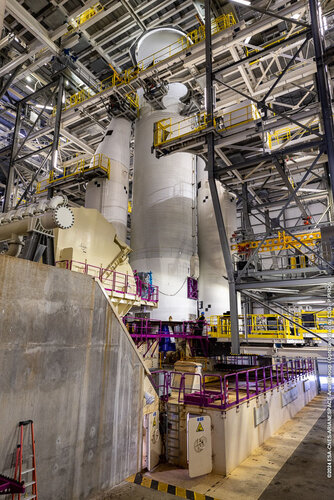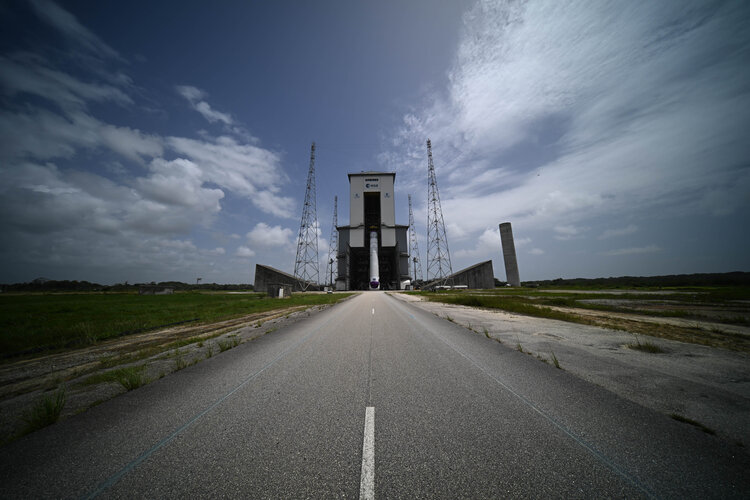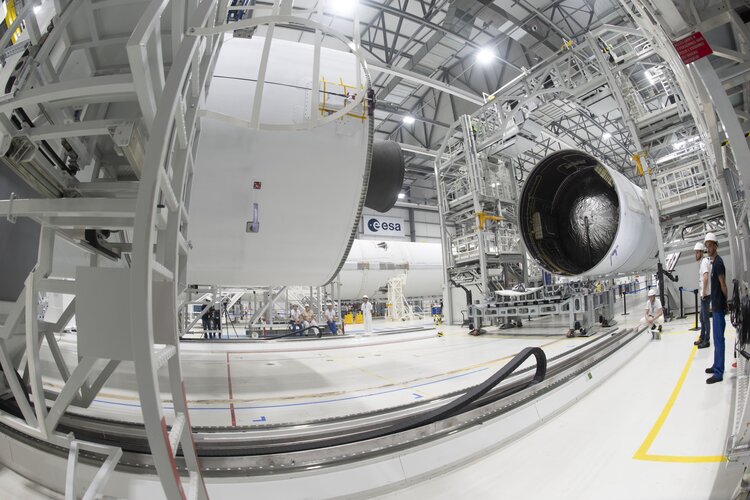Artist's view of the Ariane 6 components with two boosters

 Image: Artist's view of the Ariane 6 components with two boosters
Image: Artist's view of the Ariane 6 components with two boosters
#launchers #space #science #esa #europeanspaceagency
posted by pod_feeder_v2
One person like that

 Image: Artist's view of the Ariane 6 components with two boosters
Image: Artist's view of the Ariane 6 components with two boosters
#launchers #space #science #esa #europeanspaceagency
posted by pod_feeder_v2

 Image: Artist's view of the Ariane 6 components and payload with two boosters – blue background
Image: Artist's view of the Ariane 6 components and payload with two boosters – blue background
#launchers #space #science #esa #europeanspaceagency
posted by pod_feeder_v2


Europe’s newest rocket soon launches, taking with it many space missions each with a unique objective, destination and team at home, cheering them on. Whether launching new satellites to look back and study Earth, peer out to deep space or test important new technologies in orbit, Ariane 6’s first flight will showcase the versatility and flexibility of this impressive, heavy-lift launcher. Read on for all about 3Cat-4, then see who else is flying first.
#launchers #space #science #esa #europeanspaceagency
posted by pod_feeder_v2

 Video: 00:02:35
Video: 00:02:35
In April 2024, Ariane 6’s central core – the main body of the rocket – was stood tall at the launch zone and connected to its two solid-fuel boosters. This exciting moment means only one thing: it’s the start of the first launch campaign.
The main stage and upper stage make up the core stage, and they were autonomously driven at 3 km/h from the rocket assembly building to the launch pad, 800 m away. Then lifted by a crane, the Ariane 6 core was stood upright on the launch table.
The two boosters were transported to the launch pad on a specially designed truck and then configured with the rocket body, now holding it upright.
Ariane 6 is due to launch in summer 2024. The heavy-lift rocket will inaugurate a new era of autonomous European space transportation, powering Europe into space to realise its ambitions on the world stage. It will lift off from a modern launch complex at Europe’s Spaceport in French Guiana, carrying with it not just a variety of spacecraft, but also European goals for prosperity and autonomy.
Access the related broadcat quality video material.
#launchers #space #science #esa #europeanspaceagency
posted by pod_feeder_v2

 Image: Ariane 6's boosters are connected to the rocket's central core
Image: Ariane 6's boosters are connected to the rocket's central core
#launchers #space #science #esa #europeanspaceagency
posted by pod_feeder_v2

 Image: Transporting second booster for first Ariane 6
Image: Transporting second booster for first Ariane 6
#launchers #space #science #esa #europeanspaceagency
posted by pod_feeder_v2

 Image: Second booster for first Ariane 6
Image: Second booster for first Ariane 6
#launchers #space #science #esa #europeanspaceagency
posted by pod_feeder_v2

 Image: First Ariane 6 booster gets lift to launch zone
Image: First Ariane 6 booster gets lift to launch zone
#launchers #space #science #esa #europeanspaceagency
posted by pod_feeder_v2


ESA’s YPSat has been shipped to Arianespace. Following a series of successful tests confirming its readiness for deployment, the payload is now headed to Europe’s Launch Site in French Guiana. The goal of YPSat is to capture all the key phases of Ariane 6's inaugural flight.
#launchers #space #science #esa #europeanspaceagency
posted by pod_feeder_v2

 Image: Ariane 6 central core in launch position
Image: Ariane 6 central core in launch position
#launchers #space #science #esa #europeanspaceagency
posted by pod_feeder_v2

 Video: 00:02:19
Video: 00:02:19
They say it takes a village to raise a child. To launch a rocket, we have the combined expertise and passion of Space Team Europe. Julien Guiridlian is one of many making the first Ariane 6 launch possible and has been interviewed as part of a series highlighting some of the people that make up this dream team.
Working for France’s space agency CNES, Julien is Ariane launch complex assistant, which means he takes care of the ground segment for the combined tests on Europe’s new rocket. Julien takes care of coordinating everything from the fuel for the launcher, to ensuring there is electricity and the mechanical connections between the rocket and the launch pad. Ariane 6 is all about teamwork, and the team is ready for the match.
Stay tuned for more from #SpaceTeamEurope: an ESA space community engagement initiative to gather European space actors under the same umbrella sharing values of leadership, autonomy, and responsibility.
Find more videos from Space Team Europe.
#launchers #space #science #esa #europeanspaceagency
posted by pod_feeder_v2

 Video: 00:04:45
Video: 00:04:45
They say it takes a village to raise a child. To launch a rocket, we have the combined expertise and passion of Space Team Europe. Michel Bonnet is one of many making the first Ariane 6 launch possible, and has been interviewed as part of a series highlighting some of the people that make up this dream team.
“Who has not dreamed of working in the space sector?” he says, recalling how he built small rockets as a teenager using sodium chlorate, sulphur and sugar. In 1995, after years of work with helicopters and nuclear submarines, Michel started work in the space sector. For Ariane 6’s first flight, he is the Inaugural Flight Principal covering mission preparation, including the several small satellites being launched, and the launch campaign follow-up.
Michel is also head of a team of six engineers who are together working on the future possibilities for Ariane 6, often focussing on potential exploratory missions after 2030 and what modifications would be necessary to the launcher to make them feasible.
Stay tuned for more from #SpaceTeamEurope: an ESA space community engagement initiative to gather European space actors under the same umbrella sharing values of leadership, autonomy, and responsibility.
#launchers #space #science #esa #europeanspaceagency
posted by pod_feeder_v2

 Image:
Image:
Teams from ESA, CNES, ArianeGroup and Arianespace working diligently to get the new European rocket Ariane 6 ready for launch pose for a photo with French President Emmanuel Macron who visited Europe's Spaceport on 26 March 2024. The President addressed the teams working on Ariane 6 in the launcher assembly building, with the rocket's upper stage and core stage that will soar into space soon in the background. Also present was Toni Tolker-Nielsen, ESA’s Director of Space Transportation, Philippe Baptiste CEO of France’s space agency CNES, Martin Sion CEO of ArianeGroup, Stéphane Israël CEO of Arianespace and François Ringuet, the mayor of Kourou, French Guiana.
#launchers #space #science #esa #europeanspaceagency
posted by pod_feeder_v2

 Video: 00:01:24
Video: 00:01:24
Scenes from Europe’s Spaceport in French Guiana during the unloading of the launch vehicle adapter and ballast at the final assembly building for the first Ariane 6 flight on 19 January 2024.
Placed on the top of Europe’s new rocket the launch vehicle adapter connects the launcher to the ballast and passengers for its first flight. The payloads will arrive later this year and prepared at the payload preparation facilities to prepare the cargo for launch and connecting everything to this payload adapter.
Once complete the payload is put under the protective nose cone. This fairing will ensure the cargo is kept at a nice ambient temperature and humidity while also protecting it from the elements. It also provides a sleek aerodynamic shape to help Ariane 6 overcome the atmosphere as it thunders upwards to space.
Teams from ArianeGroup, France’s space agency CNES and ESA are working hard to get the first Ariane 6 to fly ready to be moved to the all-new launch pad, where the central core will be raised to its vertical launch position. This is also where the two boosters for the first Ariane 6 flight will be connected. Lastly the payloads will be placed on top of the central core and covered by the fairing – Ariane 6’s nose cone that splits vertically in two.
Ariane 6 is an all-new design, created to succeed Ariane 5 as Europe's heavy-lift launch system. With Ariane 6's upper stage restart capability, Europe's launch capability will be tailored to the needs of multiple payload missions, for example to orbit satellite constellations. This autonomous capability to reach Earth orbit and deep space supports Europe's navigation, Earth observation, scientific and security programmes. Ongoing development of Europe's space transportation capabilities is made possible by the sustained dedication of thousands of talented people working in ESA's 22 Member States.
Access the related broadcast quality video material.
#launchers #space #science #esa #europeanspaceagency
posted by pod_feeder_v2

 Image:
Image:
Artist's view of the Ariane 6 rocket on it’s first flight as its fairing – a nose cone that splits into two vertically – showing its passengers at the top of the launcher. The view shows Ariane 6 already three minutes into launch after Ariane 6 will have jettisoned its two boosters after liftoff from Europe's Spaceport in Kourou, French Guiana.
The passengers Ariane 6 will launch into space on its inaugural flight include several satellites, deployers and experiments from space agencies, companies, research institutes, universities and young professionals on its first flight.
From established players like NASA to students designing their first ever satellite, these missions will measure gamma rays, track wildlife, test self-healing solar cells, confirm the theory of black body radiation and more. There's a smart-farming satellite, a radio beacon demonstrator, experiments that will remain attached to the rocket's payload ‘adaptor’ and even capsules destined to reenter Earth’s atmosphere to test new materials – Ariane 6’s first flight will be packed with technology as its first payloads are sent on their way into space.
This plethora of missions is being supplied by three types of organisations: commercial companies, space agencies and universities. Together they have been building hardware to test and prove their technology works in space; satellites to measure weather on Earth or in the Solar System; study the Sun and perform other science experiments.
The new heavy-lift rocket Ariane 6 has been designed for all possible futures, and at its core is maximum versatility. Ariane 6 can put any satellite or payload into any orbital path. This is made possible with the new restartable Vinci engine that will power up the Ariane 6 upper stage again and again, stopping and starting to insert spacecraft into any orbit they need to be. The launcher stores enough fuel for a final burn, once its passengers are deployed, to deorbit and reenter safely back through Earth’s atmosphere.
#launchers #space #science #esa #europeanspaceagency
posted by pod_feeder_v2

 Image: Connecting Ariane 6 upper and core stage
Image: Connecting Ariane 6 upper and core stage
#launchers #space #science #esa #europeanspaceagency
posted by pod_feeder_v2

 Image: First booster for Ariane 6 ready
Image: First booster for Ariane 6 ready
#launchers #space #science #esa #europeanspaceagency
posted by pod_feeder_v2